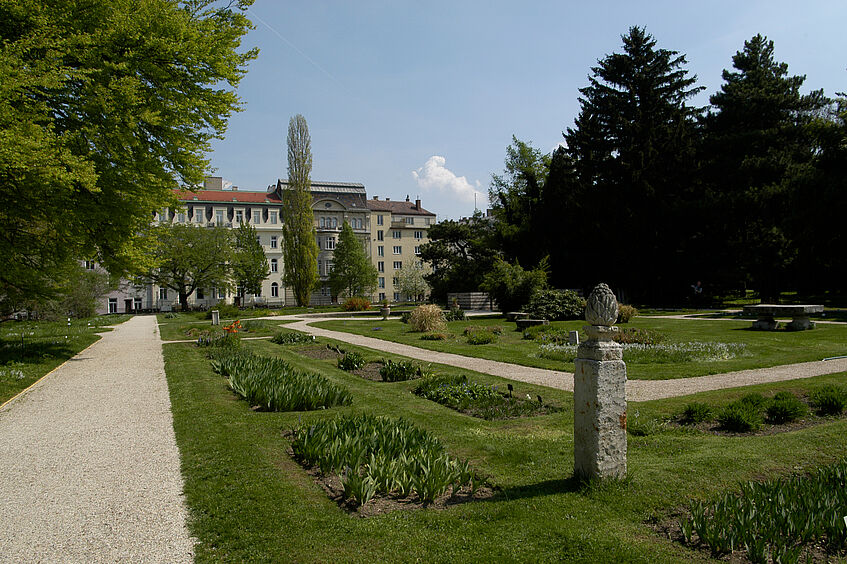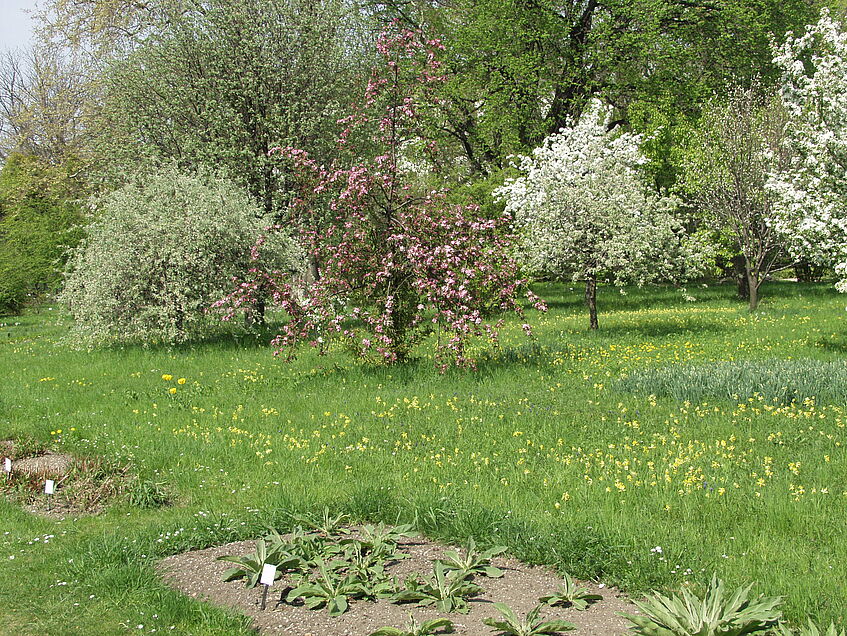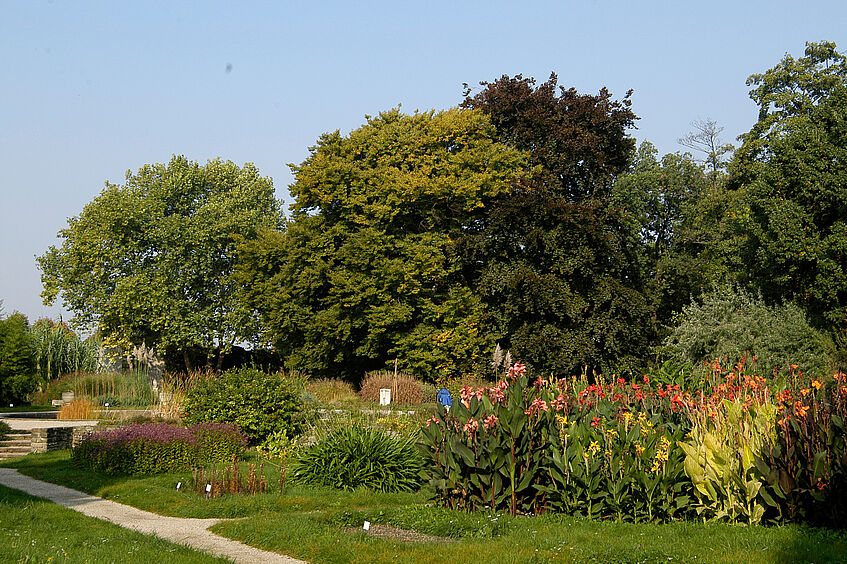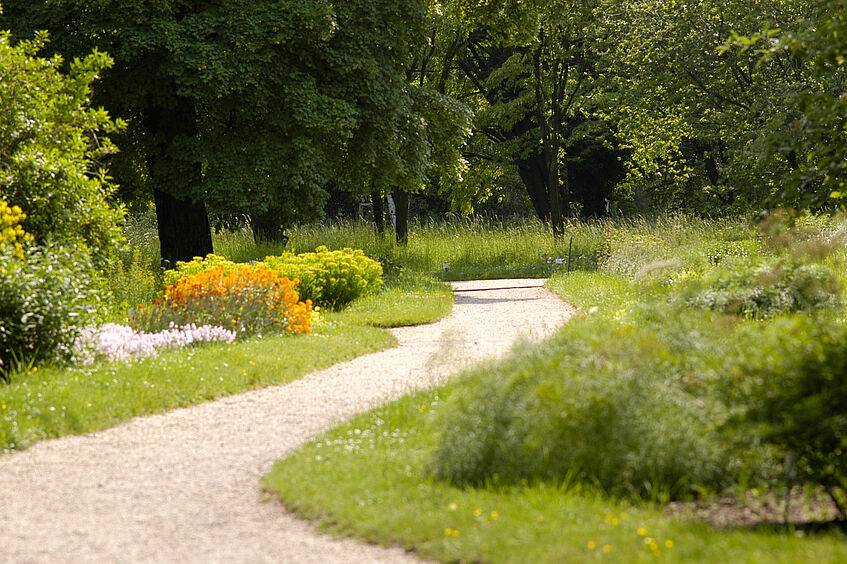Systematic Group

Systematische Gruppe © BGUW_R. Hromniak

Systematische Gruppe © R. Chizzola

Systematische Gruppe © BGUW_R. Hromniak

Systematische Gruppe © BGUW_R. Hromniak
Group numbers: 1-14, 16-19
The Systematic Group of the University of Vienna's Botanical Garden occupies about half of the publicly accessible outdoor garden area. It is the largest among the display groups and is subdivided into 18 sectors.
Systematic groups are permanent fixtures in most botanical gardens. Every such display group is designed to highlight the kinship relations among the individual plant species, and the plants are arranged accordingly in the garden landscape. These often complex botanical "systems" reflect hard science and are deemed only minimally relevant for the general public. Moreover, such strict frameworks may be less optimal from an aesthetic standpoint than, for example, an alpine garden. This is why many gardens typically reduce such “systems” to a minimum today and often locate them decentrally in more peripheral zones.
The University of Vienna has been conducting research on the phylogenetic relationships within the plant kingdom for more than two centuries. The presentation of the "plant system" therefore remains a core mission of the university's Botanical Garden.
The central location and the space given to the Systematic Group reflect the importance afforded to this topic from the onset by its initiator Stephan Endlicher in the mid-19th century. Endlicher's opus "Genera plantarum secundum ordines naturales disposita", published in 1836 and implemented in the design of the garden, was already based on phylogeny. The date of this publication is all the more significant from a scientific perspective because Darwin's "On the origin of Species" – whose theories on evolution revolutionized science as a whole – wasn't published until almost two decades later.
The original garden design displayed not only the dicotyledonous (featuring two embryonic leaves or cotyledons) but also the monocotyledonous plants (only one cotyledon), gymnosperms and even algae. The latter were cultivated in the water basins, which had been adopted from the original Baroque garden layout. Many new plant species were raised at that time. A historical catalog registered the overall number at over 8000 species!
The layout of the Systematic Section was based on a very clever didactic approach that incorporated the Garden's topography. For example, the morphologically "less developed" species were placed in the northern, lower-lying part of the garden. The more highly developed species were positioned “higher up” from the landscape perspective. Species belonging to the same genus were planted side by side, closely related genera were arranged in the same or in adjoining beds. The lowest rungs of the system were occupied, in addition to the magnolia family (Magnoliaceae), by numerous trees, among them members of the sycamore family (Platanaceae), the olive family (Oleaceae; lilacs, for example, belong to this family), and Sapindaceae (horse chestnuts, genus Aesculus).
This was also the location of roses (family Rosaceae) or papilionaceous plants (Fabaceae). The upper garden areas harbored those families that Endlicher had categorized as being the most highly developed. This included composite plants (Asteraceae), which modern systems also position high up on the phylogenetic tree. The monocotyledonous species (monocots) then adjoined the system comprising the dicotyledons (dicots).
The Systematic Section, introduced by Endlicher and developed foremost by Eduard Fenzl (especially the dicots), remained largely unchanged for many decades both as a unit and regarding its planting. The woody plants are a case in point. Several of them, for example the two tulip trees (Liriodendron tulipifera) in Group 3, go all the way back to when the system was established. This defines the value of this unit – a priceless document from a history-of-science perspective. Its setting as a Systematic Section of a botanical garden is unique.
The step from a system of the past to the system of the future
Any system merely represents a snapshot of the current state of knowledge. And every system in a botanical garden is only as good as it is internally consistent and clearly attributable to a certain era. The Botanical Garden's system regularly underwent smaller adaptations. Historical plant maps help determine which changes were made and when. A comprehensive plant map of the herbaceous species from the period 1894-1897 (under the directorship of Anton Kerner von Marilaun) is a particularly valuable record of such changes. The original is housed in the archives of the University of Vienna. The “round-beds” in that system are clearly depicted on this map, with one species being listed per bed.
Over the last two decades, modern research methodologies and current results, especially on the molecular level, have yielded many new insights into the phylogenetic relationships of plants. In the framework of the University of Vienna's 650-year anniversary, the decision was made to portray this state of the art in a clear and simple manner.
Nonetheless, we are also making every effort to maintain and explain those aspects of the garden – reflected in the plantings – that mark important developmental steps in the history of science. The Endlicher-Fenzl-Kerner-Weg project is a first step in this direction. This pathway is located in the center of the Systematic Group and was inaugurated in 2015. It highlights selected aspects in the historical development of the “system” at the Botanical Garden, especially in the context of shifts and advances in scientific-botanical knowledge. Those changes also mirror the broader socio-economic developments of each era.
Plant portraits and information sheets of this display group
- Aesculus parviflora - Schwärmer-Rosskastanie, Strauch-Rosskastanie
- Clerodendrum trichotomum - Losbaum
- Cobaea scandens - Glockenrebe
- Colchicum autumnale - Herbstzeitlose
- Cornus - Hartriegel
- Crocus - Krokusse nicht nur im Frühling
- Davidia involucrata - Taschentuchbaum
- Diospyros lotus - Lotospflaume
- Elaeagnus angustifolia - Schmalblatt-Ölweide
- Endlicher-Fenzl-Kerner-Weg
- Ficus carica - Feigenbaum
- Fritillaria
- Frühlingsgeophyten im Botanischen Garten
- Ginkgo biloba
- Gunnera manicata - Mammutblatt
- Hamamelis - Zaubernuss
- Helleborus
- Jubiläums-Dahlie
- +Laburnocytisus adamii - Goldregengeissklee
- Liriodendron tulipifera - Tulpenbaum
- Loranthus europaeus - Eichenmistel
- Magnolien-Quartier
- Maclura pomifera - Osagedorn
- Melianthus comosus - Honigstrauch
- Nelumbo nucifera - Indische Lotosblume
- Paeonia - Pfingstrose
- Paeonia lactiflora - Chinesische Pfingstrose
- Paeonia rockii (Paeoniaceae) - Die Rock-Strauch-Pfingstrosen
- Parrotia persica - Parrotie, Eisenholzbaum
- Paulownia tomentosa - Chinesischer Blauglockenbaum, Kaiserbaum
- Platanus sp. - Platane
- Poncirus trifoliata - Bitterorange
- Rhododendren
- Salvia - Salvien
- Syringa - Flieder
- Systematische Gruppe - Verwandtschaftsbeziehungen innerhalb der Bedecktsamer
- Systematische Gruppe - Gruppe 1: Monokotyledonen - Acorales, Alismatales, Dioscoreales
- Systematische Gruppe - Gruppe 1: Basale Angiospermen
- Systematische Gruppe - Gruppe 2: Monokotyledonen - Asparagales
- Systematische Gruppe - Gruppe 3: Monokotyledonen - Commeliniden
- Systematische Gruppe - Gruppe 4: Basale Eudikotyledonen
- Systematische Gruppe - Gruppe 5: Monokotyledonen - Liliales
- Systematische Gruppe - Gruppe 6: Saxifragales, Vitales
- Systematische Gruppe - Gruppe 7: Fabiden - Malpighiales, Oxalidales, Celastrales, Zygophyllales
- Systematische Gruppe - Gruppe 8: Fabiden - Rosales, Fagales, Fabales, Cucurbitales
- Systematische Gruppe - Gruppe 9: Malviden - Malvales, Brassicales, Sapindales
- Systematische Gruppe - Gruppe 10: Caryophyllales
- Systematische Gruppe - Gruppe 11: Cornales, Ericales
- Systematische Gruppe - Gruppe 12: Lamiiden - Lamiales
- Systematische Gruppe - Gruppe 13: Malviden - Myrtales, Geraniales
- Systematische Gruppe - Gruppe 14: Campanuliden - Dipsacales
- Systematische Gruppe - Gruppe 16: Lamiiden - Solanales, Gentianales, Boraginales
- Systematische Gruppe - Gruppe 17: Campanuliden - Apiales
- Systematische Gruppe - Gruppe 18: Campanuliden - Asterales
- Tulipa - Tulpen
- Viburnum - Schneeball
- Viscum - Mistel
- Vitex agnus-castus - Mönchspfeffer
- Von blauen Blütensternen - Scilla, Othocallis und Prospero - Hyacinthaceae
- Was sind Geranien?
- Yucca - Palmlilie
- Zanthoxylum (Rutaceae) - Vielfältige Stachelesche
